NADIS: Swine dysentery
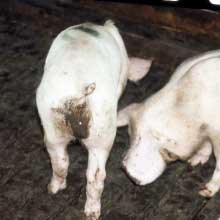
By Mark White BVSc DPM MRCVS
 |
|---|
Typical appearance and demeanour of a pig affected with clinical Swine Dysentery |
Dysentery, as a pathological condition, is typified by bloody diarrhoea and in its original form this is how the disease presented in pigs. However, Brachyspira hyodysenteriae is not the only cause of bloody diarrhoea in the pig, but conversely it is now recognised that not all strains of Brachyspira hyodysenteriae cause classic signs of Swine Dysentery.
Clinical Presentation
The typical pig affected with swine dysentery will appear dull, depressed and inappetant with sunken (or slab) sides to its abdomen.
Dehydration is common. The faeces will range from soft to almost water, containing blood, mucous and in severe cases necrotic gut lining. It will give off a distinctive and unpleasant smell. The disease runs over a number of days, with initially raised rectal temperatures up to 41C (106°F) but this will fall over a few days. Death can result early on or later and may itself be the result of dehydration/salt poisoning.
As a group disease, signs will spread steadily within and between pens over a number of days – rather than explosively. Untreated and uncontrolled, the disease will persist within dynamic production systems for prolonged periods of time, if not permanently.
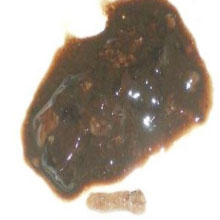 |
|---|
Typical bloody mucoid product of an affected pig |
Diet can have dramatic effects on the severity of the disease and some studies have shown that even in the face of severe challenge, pigs fed on cooked white rice show little sign. Swine Dysentery is a disease of the large intestine (colon) and this suggests that digestibility of the diet can affect the growth of the organism in the gut and the damage it subsequently does – the better the diet is digested in the small intestine, the less substrate will pass down the gut on which the organism will thrive.
Individual pigs that survive infection can range from fully recovered to chronically stunted with permanent diarrhoea. In between, long-term effects may only be measurable by accurate recording of growth rates and feed conversion efficiency.
In recent years, “milder” strains of Brachyspira hyodysenteriae have been recognised which present more as a low grade, cow-pat like, grower scour than as frank dysentery. (Fig 3). However, these strains appear to have the ability to “drift” within a population, causing variable levels of disease.
Diagnosis
Swine dysentery should be suspected in any situation where spreading scour is seen particularly in growing pigs, and certainly where there is any sign of blood or mucous in the scour.
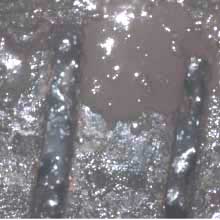 |
|---|
Milder form of Swine Dysentery may produce grey scour, with no blood or mucous, usually regarded as grower scours |
The organism can be demonstrated in faeces, gut contents and mucocal scrapings by PCR tests – which have largely superseded a range of other laboratory tests. It is possible to see spiral organisms under the microscope in wet smears prepared from typically affected gut lining. However, this is not definitive for Brachyspira hyodysenteriae.
Other diseases that can mimic swine dysentery in the growing pig include Salmonella, Swine Fever, severe Spirochaetal diarrhoea (Brachyspira pilosicoli infection) and Trichuris suis infection whereas the less specific grower scours can arise as a result of dietary indigestion, chilling and infection with a wide range of organisms that include B. pilosicoli, Yersinia, E.coli, Salmonella and Lawsonia. Secondary invasion of the colon by Balantidium coli – a commensal gut parasite – can produce signs of blood and mucous making diagnosis complex.
A full veterinary investigation of suspect disease is always necessary.
Treatment
Over the last two decades the range of treatments available for swine dysentery in the UK had declined both due to withdrawal of products (Carbadox, Arsenicals, Dimetridazole and Romidazole) or by the development of variable levels of resistance to antibiotics (e.g. Tylan).
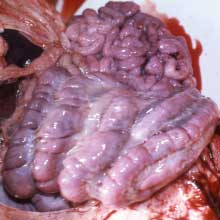 |
|---|
Oedema (fluid accumulation) within the mesentery (gut suspension mechanism) of the large intestine |
Control
The primary aim for all herds is to prevent introduction into the unit which can be achieved by:
- Attention to sourcing of stock
- Attention to biosecurity particularly with relevance to anything that can carry faeces, including lorries (knackermen, stock hauliers and feed wagons)
- Control of vermin and birds that can spread disease from farm to farm
- Control of visitors
In the indoor situation, siting of the herd well away from any other pigs is vital to avoid the risk of this and many other diseases.
Once present within the herd, the effects of disease must be carefully evaluated. In severe cases, the depressant effect on performance and high costs of continual high level medication can make the herd unsustainable, necessitating eradication strategies such as depopulation/repopulation, partial depopulation with medication regimes or pure medication eradication following sensitivity testing on cultures of Brachyspira hyodysenteriae.
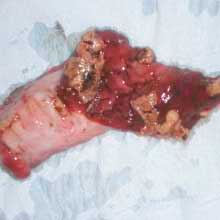 |
|---|
Necrotic tissue adhered to the lining of the colon in an advanced case if Swine Dysentery |
Effective vaccines are not currently available
Costs
Inevitably, with such a variable disease, the costs can vary dramatically. In the most severe chronically affected dynamic herds such as a breeder/feeder herd SD infection can depress herd feed conversion efficiency by 0.5 or more – requiring an extra £7 of feed/pig finished which, when added to permanent medication, mortality and non-marketable pigs etc can exceed £10/pig produced.
In milder cases, depression in performance can be offset using management and medication limiting cost to no more than £2/pig produced. However, in times of financial constraint even this may be unsustainable.
Conclusion
Swine dysentery remains a major threat to UK pig farms. It’s diagnosis is complex, requiring full veterinary involvement, but the variability and appearance of less severe forms of the disease has led to some producers regarding it as a ‘live with’ disease. Control, however, can be expensive and difficult and in all cases eradication should be considered.
Copyright © NADIS 2009 www.nadis.org.uk
